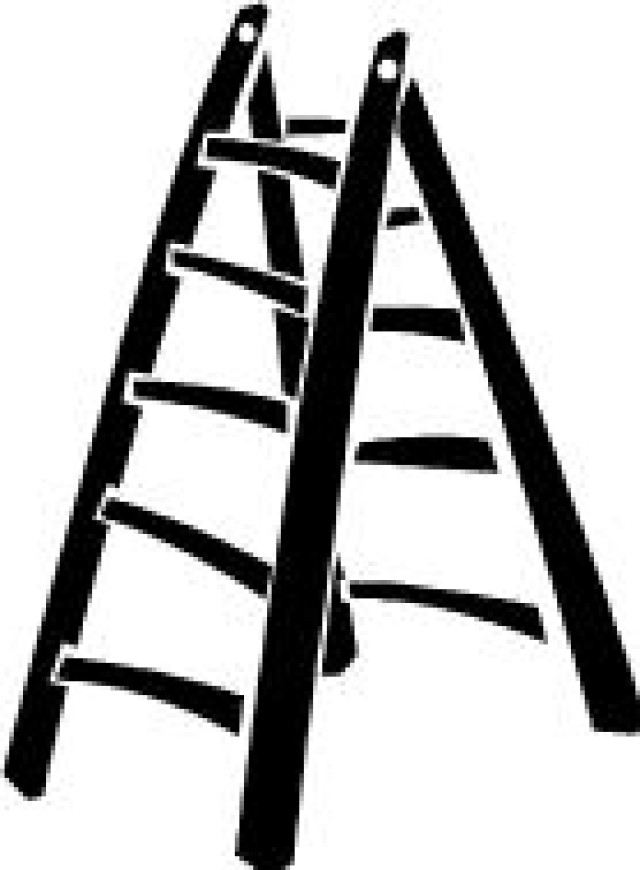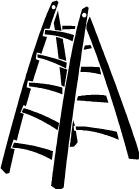FORT RUCKER, Ala. (Dec. 6, 2006) - Do your holiday plans include a trip to the emergency room' How many stitches does it take to "Git-R-Done"' Do you crawl around the attic retrieving decorations and then climb down the ladder balancing boxes, bags and artificial trees' What about hanging lights and decorations' Sooner or later your decorating activities will have you perched on a ladder challenging the law of gravity. Because that's one law that is regularly enforced, holiday activities can lead to disaster if not done cautiously.
Underwriter's Laboratory estimates about 150 people will die in ladder accidents in 2006, while another 200,000 will be seriously hurt. The Consumer Product Safety Commission reported nearly 547,000 people were treated for ladder-related injuries in 2004. Take a moment and think back on the close calls you've had on a ladder because you used poor climbing techniques. Consider the injuries that could have happened. Ask yourself if it is worth risking a broken leg-or worse-trying to carry one extra box in your load down your attic ladder.
Risk assessments aren't just for your job; they can protect you and your family at home. The following tips can help you avoid celebrating your holidays in the hospital.
<strong>Before using a ladder</strong>
<ul style="margin-top:0px;margin-bottom:0px;">
<li>Inspect the ladder before using it. Never use a ladder that is damaged, broken or bent. A ladder should be free from grease, oil, mud, snow and other slippery materials before using. </li>
<li>Always carry a single or extension ladder parallel to the ground. To balance the ladder, hold the side rail midway along the length of the ladder. Get help if you have to move a very long ladder. Always carry a stepladder in the closed position. </li>
<li>When setting up a ladder, make sure it will not hit electrical wires, tree limbs or other obstructions when it is extended. Place the feet of the ladder on firm, even ground. To keep the ladder stable, move the bottom one foot away from the wall for every four feet the ladder rises. Ladders should extend at least three feet higher than the roof. The upper and lower sections of an extension ladder should overlap to provide stability. </li>
<li>Before using a stepladder, make sure it is fully open and the spreaders or braces between the two sections are fully extended and locked. Do not place stepladders or utility ladders on boxes, countertops or unstable surfaces to gain additional height. The highest standing level on a stepladder should be two steps down from the top. </li>
</ul>
<strong>Climb to new heights - safely</strong>
<ul style="margin-top:0px;margin-bottom:0px;">
<li>The soles of your shoes should be clean to prevent slips.</li>
<li>Don't wear leather-soled shoes because they can be slippery. Make sure your shoelaces are securely tied and your pant legs can't get caught beneath your shoes. </li>
<li>When climbing, face the ladder, grip both side rails securely and stay between them. As a rule of thumb, avoid letting your belt buckle go past either side rail. </li>
<li>On single or extension ladders, never stand above the third rung from the top and never climb above where the ladder touches the wall or vertical support. </li>
<li>On stepladders, never stand on the paint shelf, spreaders or back section. </li>
<li>Never stand on the top rung of any ladder. </li>
<li>Don't overreach; it's safer to move the ladder to a new location when needed. Don't try to "jog" or "walk" the ladder to a new location while standing on it. Climb down and reposition the ladder. </li>
<li>Don't overload a ladder; it is meant to be used by only one person at a time. </li>
<li>Never use a ladder in high winds. </li>
<li>Don't use a ladder if you tire easily, are subject to fainting spells or are using medications that make you dizzy or drowsy. Also, avoid alcohol as tipping the bottle tends to lead to tipping the ladder. </li>
</ul>
<strong>If you fall </strong>
<ul style="margin-top:0px;margin-bottom:0px;">
<li>Calmly assess the situation and determine if you're hurt. </li>
<li>Get up slowly. </li>
<li>If you're too injured to stand or walk, call 911. </li>
<li>If you're not injured, rest for awhile and regain your composure before climbing again. </li>
</ul>
<strong>Pick the Right Tool</strong>
All ladders aren't created equal. While the "one-size-fits-all" approach is tempting, especially if you only have one ladder, it can leave you the loser in a battle with gravity. Just as you need to use the proper wrench to tighten a bolt, you need to use the proper ladder for the job you're doing. Inside a house, that likely means a low stepladder. If you're working outside, you may need a taller stepladder or even a single or extension ladder. The charts below provide information on the types and heights of ladders to help you can pick the right one for the job at hand.
<strong>Types of ladders</strong>
TYPE: IA
DUTY RATING: Industrial
WORKING LOAD: 300-pound maximum
TYPE: I
DUTY RATING: Industrial
WORKING LOAD: 250-pound maximum
TYPE: II
DUTY RATING: Commercial
WORKING LOAD: 225-pound maximum
TYPE: III
DUTY RATING: Household
WORKING LOAD: 200-pound maximum
<strong>Recommended ladder heights</strong>
16-foot ladder 13-foot maximum work height
24-foot ladder 21-foot maximum work height
28-foot ladder 24-foot maximum work height
32-foot ladder 29-foot maximum work height
36-foot ladder 32-foot maximum work height
<p><em>Note: These articles were reprinted from the November-December issue of ImpaX magazine, available online at https://crc.army.mil/home/</em></p>


Social Sharing